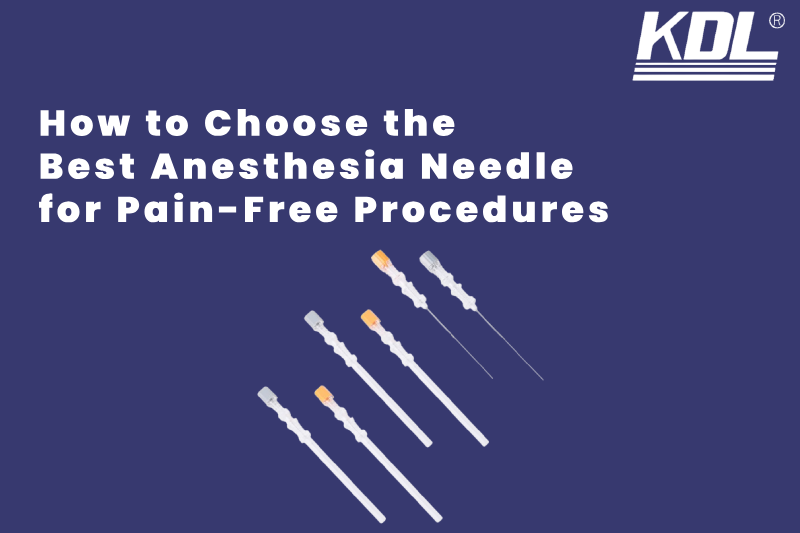
Ensuring patient safety and comfort is crucial for any medical procedure, and choosing the right anesthesia needles plays a vital role in achieving this. Anesthesia needles are used to administer anesthesia, which numbs the patient’s sensation during a medical procedure. There are various types of anesthesia needles available in the market, and selecting the appropriate one for your patients is crucial. In this blog post, we will discuss how to choose the right anesthesia needle for your patients to ensure their safety and comfort.
What is an anesthesia needle?
An anesthesia needle is a medical instrument used by healthcare professionals to administer local anesthesia to a specific area of the body before a surgical procedure or medical intervention. It consists of a slender, hollow needle attached to a syringe, allowing for the precise delivery of anesthetic medication directly into the targeted area, such as a nerve or tissue. This numbs the area and reduces or eliminates pain during the procedure, ensuring patient comfort and safety.
Types of anesthesia needles
There are three main types of anesthesia needles: spinal, epidural, and peripheral. Spinal needles are used to inject anesthesia into the cerebrospinal fluid surrounding the spinal cord, providing regional anesthesia. Epidural needles are inserted into the epidural space to deliver anesthesia near the spinal cord. Peripheral needles are used for local anesthesia in smaller areas such as fingers, toes, or facial regions.
Factors to consider when choosing an anesthesia needle
Needle gauge and length
The gauge of an anesthesia needle refers to its diameter, with larger numbers indicating a smaller diameter. The length of the needle varies depending on the type of needle and the patient’s body size.
For larger patients, a longer needle may be required to reach the desired injection site. On the other hand, shorter needles are suitable for smaller patients. It is essential to consider the patient’s body size and the area of the body where the injection is to be administered while selecting the needle gauge and length.
Needle tip design
Different needle tip designs are available, such as cutting, bevel, and pencil point. Cutting needles are sharp and cut through tissues, making them suitable for spinal anesthesia. Bevel needles have a sloping tip, making them ideal for epidural anesthesia. Pencil point needles have a rounder tip and are commonly used for peripheral anesthesia. Consider the type of procedure and the patient’s anatomy while selecting the needle tip design.
Material of the needle
Most anesthesia needle is made of stainless steel or plastic. Stainless steel needles are strong and durable, making them suitable for larger patients and more prolonged procedures. Plastic needles are softer and more flexible, making them ideal for smaller patients and shorter procedures.
Patient’s medical history and condition
It is vital to consider the patient’s medical history and current condition while choosing an anesthesia needle. Patients with bleeding disorders or allergies to certain materials may require specific types of needles. Additionally, some patients may have underlying conditions that affect their sensitivity to pain, making it necessary to choose the appropriate needle for their comfort.
Key features of comfort-enhancing anesthesia needles
Anesthesia needle manufacturers have introduced innovative features to enhance patient comfort and procedural efficiency. These features include:
Enhancing precision with Ultrasound-guided anesthesia needles
Ultrasound-guided anesthesia needles incorporate built-in ultrasound compatibility, allowing real-time visualization of needle placement and medication spread. This technology enables practitioners to target specific nerve clusters or injection sites with unparalleled accuracy, reducing the risk of complications and improving patient outcomes.
Prioritizing safety: The importance of safety anesthesia Needles
Safety anesthesia needles are design with built-in mechanisms to prevent accidental needlestick injuries and needle reuse, minimizing the risk of bloodborne infections and promoting healthcare worker safety. These mechanisms may include retractable needles, needle guards, and single-patient use designs.
Optimizing comfort: Ergonomic anesthesia needle designs
Ergonomic anesthesia needles feature user-friendly designs that prioritize practitioner comfort and control during needle insertion and medication administration. These needles may incorporate textured grips, ergonomic handles, and intuitive control mechanisms to reduce hand fatigue and enhance procedural precision.
Navigating needle safety
Ensuring the sterility and safety of anesthesia needle is paramount to prevent infections and protect both patients and healthcare providers. Key considerations for needle safety include:
Ensuring sterility: The role of disposable anesthesia needles
Emphasizing the importance of using sterile, disposable anesthesia needle for each patient encounter to reduce the risk of cross-contamination and infection transmission.
Educating healthcare staff on proper needle disposal procedures and sharps injury prevention techniques to minimize occupational hazards.
Conclusion
In conclusion, selecting the right anesthesia needle is not merely a technical decision but a crucial aspect of patient care. By understanding the diverse options available and considering factors such as gauge, length, and safety features, healthcare professionals can ensure pain-free procedures and optimal patient comfort. Remember, a well-informed choice of anesthesia needle can make all the difference in transforming medical interventions into positive experiences for both patients and practitioners.

